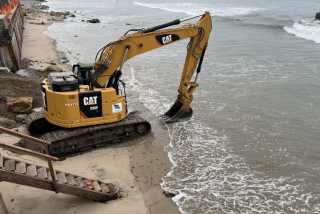Speculator Ratchets Up Coastal Costs
- Share via
It took a Las Vegas land speculator with an eye for California’s coastline to recognize the value of an arcane legal document known as a certificate of compliance.
Applying for these certificates, a legal mechanism to grandfather in ancient underlying parcels, has long been used by developers to subdivide their property outside of the usual local planning process.
But Brian Sweeney was among the first to use this legal avenue not to expedite new construction, but to boost the price of land sold for preservation as open space.
Sweeney’s first deal was in Santa Cruz County, where he took an option in 1997 to buy the 7,000-acre Coast Dairies property that ran along nearly seven miles of coastline.
Sweeney optioned it initially as part of a planned land swap, said Sandy Lydon, a retired professor who worked with him. Sweeney declined to be interviewed.
When the swap fell through, Sweeney tried to coax environmentalists to buy the property. His option was costing $1 million a month; he needed to do something fast.
Conservation groups acknowledged the land’s beauty and importance but declined to buy because they had more pressing purchases.
Lydon said the experience taught Sweeney a lesson: “He got the idea that to get the environmentalists off their butts, what he needed to do was create a crisis.”
So Sweeney hired attorneys and surveyors to dig into old property records. They found 139 underlying parcels and filed for certificates of compliance on all of them.
He dumped his documents in the county’s lap and announced, “I have 139 buyers ready to build monster homes.” That, Lydon said, “got everybody’s attention.”
Conservation groups were suddenly ready to deal. The price was now double that of an earlier Coastal Conservancy option on the land. But the choice was to meet Sweeney’s price or see the gentle coastal plains and redwood forests turned into a private enclave for the wealthy.
The Save the Redwoods League and the Trust for Public Land helped amass money from nonprofit foundations and taxpayers for the $43-million purchase.
Sweeney’s second coup came farther down the coast in Big Sur. He bought a 1,226-acre ranch from the estate of the late Allen Funt, creator of TV’s “Candid Camera.”
Funt’s ranch in Big Sur is the backdrop to one of the most photographed places in America: the graceful bridge where California 1 spans the mouth of Bixby Creek, far above the Pacific.
Sweeney produced certificates of compliance for nine parcels and threatened to built mansions on each of them.
Once again, alarm bells sounded in the environmental community. Sweeney sold the bulk of the Funt ranch to the Trust for Public Land for more than $26 million--a profit of about $24 million.
Environmentalists have been buzzing ever since.
“This type of land-churning for greed is totally inappropriate,” thundered Rep. Sam Farr (D-Carmel), who noted that the property was purchased with a combination of private and taxpayer funds.
Lydon said environmentalists must bear some responsibility for how things played out.
Environmentalists aren’t the only ones to take a lesson.
“Obviously,” Lydon said, “the Hearst people learned something.”
More to Read
Sign up for Essential California
The most important California stories and recommendations in your inbox every morning.
You may occasionally receive promotional content from the Los Angeles Times.










